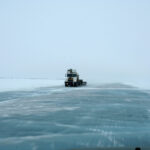7 Tips for Staying Safe on the Ice

Although we generally tell workers to avoid ice on the job lest they slip and fall, some workers simply can’t avoid the ice because of the nature of their jobs. For example, workers may need to cross over ice covers on lakes, rivers, ponds, etc. by foot or vehicle to get to a worksite. Some may even need to work on the ice itself.
To protect workers in such circumstances, some OHS laws have specific requirements for working on ice over water, such as a frozen lake or river. For example, Newfoundland’s OHS regulations says that when a worker must travel over or work on ice over water, the employer must test the ice to ensure that it can support the load placed on it.
To adequately protect your workers if they must cross over or work on an ice cover, create and implement an ice safety policy.
And here are seven tips from the Lifesaving Society you can give to workers to help them stay ‘ice smart’:
- Keep away from unfamiliar paths or unknown ice.
- Avoid travelling on ice at night.
- If you must venture onto the ice, wear a thermal protection buoyant suit to increase your chances of survival if you fall through it. If you don’t have one, wear a lifejacket/PFD over an ordinary snowmobile suit or layered winter clothing,
- Avoid slushy ice, thawed ice that has recently refrozen, layered or rotten ice caused by sudden temperature changes, and ice near moving water (i.e., rivers or currents). Clear hard ice is the only kind of ice recommended for travel.
- Never go on the ice alone; a buddy may be able to rescue you or go for help if you get into difficulty.
- Before you leave shore, inform someone of your destination and expected time of return.
- Assemble a small personal safety kit no larger than the size of a man’s wallet to carry with you. The kit should include a lighter, waterproof matches, magnesium fire starter, pocketknife, compass and whistle. You should also carry ice picks, an ice staff, a rope and a cell phone.